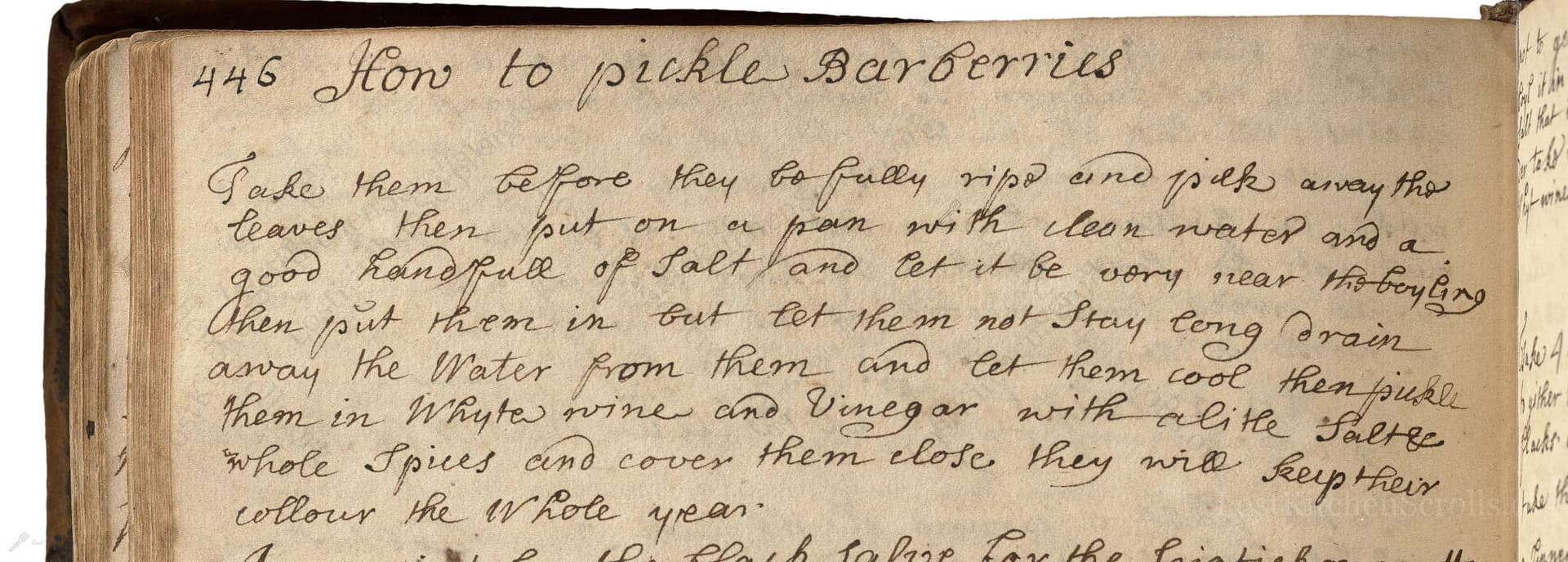How To Pickle Barberries
From the treasured pages of Cookbook
Unknown Author

How To Pickle Barberries
"Take them before they be fully ripe and pick away the leaves then put on a pan with clean water and a good handfull of Salt and let it be very near the boyling then put them in but let them not stay long drain away the Water from them and let them cool then pickle them in Whyte wine and vinegar with a little Salt &c whole Spices and cover them close they will keep their collour the Whole year."
Note on the Original Text
This recipe is typical of its time, written in continuous prose without clear measurements or times—relying on the cook's judgment and familiarity with the process. Spelling reflects the period ('boyling' for boiling, 'Whyte' for white). Directions are practical, focused on method rather than precise science. Such recipes expected a degree of prior knowledge and skill, and shared culinary wisdom in an oral or note-form tradition.

Title
Cookbook (1706)
You can also click the book image above to peruse the original tome
Writer
Unknown
Era
1706
Publisher
Unknown
Background
Step back to the early 18th century with this charming culinary collection, brimming with period recipes that tantalize the tastebuds and offer a delicious glimpse into historic kitchens.
Kindly made available by
Folger Shakespeare Library
This recipe dates from around 1706, a period when preserving fruit and vegetables was essential for availability outside of harvest seasons. Barberries were valued both for their tart flavor and their vibrant color, often added to dishes for visual appeal as well as taste. The recipe comes from a time when English kitchens were adept at pickling all kinds of garden produce, and using wine and vinegar for pickling was common among those with access to more luxurious ingredients. Barberries are less common today, but were highly prized in the early modern period. Their preservation was part of the larger tradition of sweet and sour flavors in British cookery.

In the early 18th century, cooks would have used a copper or iron pan for blanching the fruit over a wood- or coal-fired hearth. A coarse sieve or cloth would have been used for draining. The pickling would happen in stoneware or glass jars, sealed with parchment or bladder and tied with string. All work would be done by hand, with a very practical eye to hygiene and preservation.
Prep Time
5 mins
Cook Time
5 mins
Servings
10
We've done our best to adapt this historical recipe for modern kitchens, but some details may still need refinement. We warmly welcome feedback from fellow cooks and culinary historians — your insights support the entire community!
Ingredients
- 1 pound fresh barberries (unripe or just underripe)
- 4 cups water
- 1 ounce (2 tablespoons) salt (for blanching)
- 1 cup dry white wine
- 1 cup white wine vinegar
- 0.35 ounce (2 teaspoons) salt (for pickling)
- 2-3 whole cloves
- 1-2 cinnamon sticks
- 3-5 black peppercorns
- 1-2 allspice berries (optional)
Instructions
- Take fresh barberries before they are fully ripe, removing any leaves.
- In a saucepan, bring 4 cups of water with 1 ounce (about 2 tablespoons) of salt close to boiling.
- Add the barberries and blanch them briefly (about 30 seconds to 1 minute), then drain immediately and allow to cool.
- Prepare a pickling solution using 1 cup dry white wine, 1 cup white wine vinegar, 0.35 ounce (about 2 teaspoons) salt, and a selection of whole spices (such as 2-3 whole cloves, 1-2 cinnamon sticks, a few black peppercorns, and 1-2 allspice berries).
- Place the cooled barberries in a clean jar, cover with the pickling liquid and spices, and seal tightly.
- Store in a cool place.
- The barberries will retain their bright color for up to a year.
Estimated Calories
15 per serving
Cooking Estimates
It takes about 5 minutes to get your ingredients and workspace ready. You need around 5 minutes for blanching and making the pickling liquid. This makes a jar with about 10 servings as a condiment or side. Each serving is very low in calories because it is mostly vinegar, spices, and berries.
As noted above, we have made our best effort to translate and adapt this historical recipe for modern kitchens, taking into account ingredients nowadays, cooking techniques, measurements, and so on. However, historical recipes often contain assumptions that require interpretation.
We'd love for anyone to help improve these adaptations. Community contributions are highly welcome. If you have suggestions, corrections, or cooking tips based on your experience with this recipe, please share them below.
Join the Discussion
Rate This Recipe
Dietary Preference
Main Ingredients
Culinary Technique

Den Bockfisch In Einer Fleisch Suppen Zu Kochen
This recipe hails from a German manuscript cookbook compiled in 1696, a time whe...

Die Grieß Nudlen Zumachen
This recipe comes from a rather mysterious manuscript cookbook, penned anonymous...

Ein Boudain
This recipe comes from an anonymous German-language manuscript cookbook from 169...

Ein Gesaltzen Citroni
This recipe, dating from 1696, comes from an extensive anonymous German cookbook...
Browse our complete collection of time-honored recipes



